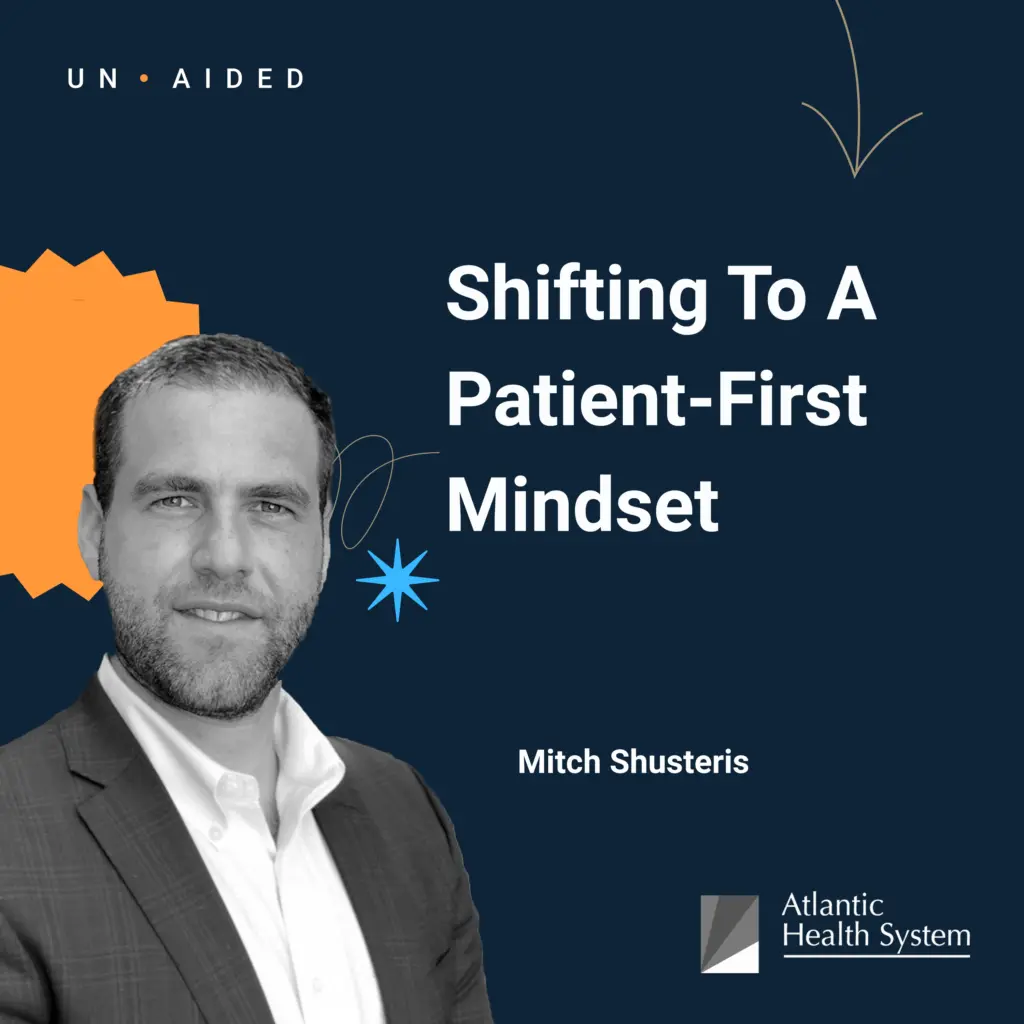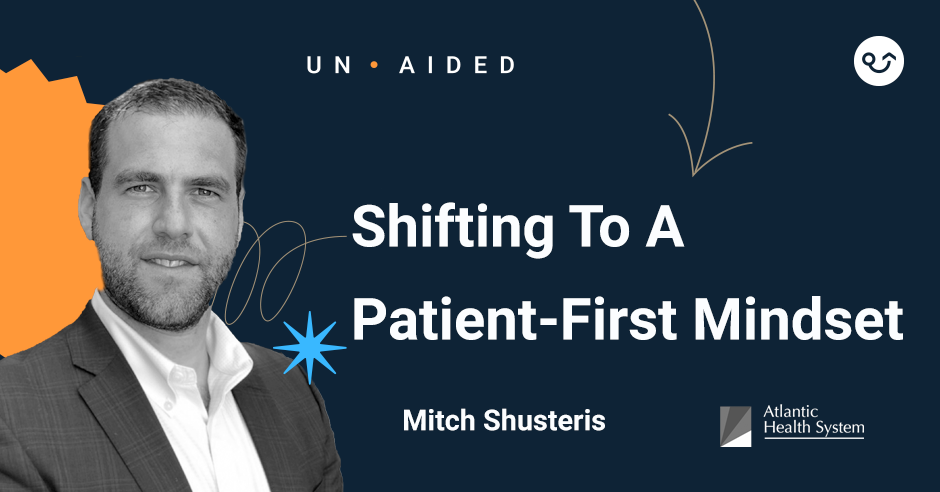
Healthcare Marketing: Shifting To A Patient-First Mindset With Mitch Shusteris
Posted in:
Mitch Shusteris joins the Win-Grin podcast to discuss the shift from a service line-centric approach to a patient-first approach to marketing. Mitch is the Director of Physician Enterprise Marketing at Atlantic Health System, and leads a team that is responsible for the digital and traditional marketing efforts of over 1,500 physicians and advanced practice clinicians across more than 400 sites of care in Central, Northern New Jersey and Northeast Pennsylvania. He believes that you need to know your community if you want to market to them, and shares his approach to topics like telehealth innovation, communication strategy, and more.
—
Watch the episode here:
Listen to the podcast here:
Healthcare Marketing: Shifting To A Patient-First Mindset With Mitch Shusteris
We welcome Mitch Shusteris to the show. Mitch is the Director of Physician Enterprise Marketing at Atlantic Health System based in Morristown, New Jersey. Mitch’s team is responsible for the digital and traditional marketing efforts of over 1,500 physicians and advanced practice clinicians across more than 400 sites of care in Central, Northern New Jersey and Northeast Pennsylvania. Let’s get into it.
—
Mitch, welcome to the show.
Thanks for having me on.
Welcome to the tropical version of the show coming to you from South Florida, which you lived in for a little bit.
I did live in Aventura which is about ten minutes North of Miami Beach back in 2003.
Is that where you grew up? Where are you from originally?
I was born in New York City and lived most of my life in New Jersey. We moved down to South Florida when my grandparents decided to retire. My parents thought, “Let’s get out of the cold.” We realized that South Florida was not for us pretty quickly and we moved back to New Jersey to finish up high school.
My parents are trying to convince my wife and item to move down here. Is the moral of the story, “Do not do it until you are also ready to retire?”
Life down there is different. It is slower. Going to the bank is a half-day activity when the Northeastern New York City environment is like, “I got to get in and out in five minutes.” It is a different culture to get used to. Weather-wise, you have me beat because it is 27 degrees out here in New Jersey, but the lifestyle is a bit different. It is a great place to visit but different to live in.
Did you grow up in the city?
No. We moved suburbs of New York City rather quickly when I was about two years old.
I’m from Long Island. I’m sure if we played some Jewish geography, we would know a bunch of people.
If you are Jewish, it’s New York City, Long Island, and New Jersey. Those are your choices.
You grew up in New York. Your family is in Florida. How did you get into healthcare marketing originally?
My family has come from healthcare. My grandmother was one of the chief doctors in Moscow back in the ‘60s and ‘70s. My grandmother and mother immigrated from the Soviet Union to New York City in 1977. She decided to continue her journey as a physician. She had to learn the English language and recertify on the board, and she did it. She has been my inspiration for healthcare.

Patient-First Mindset: The best marketing tactic is patient-first. Instead of thinking of individual organs that you’re trying to build a volume for, think about your marketing efforts through the eyes of the patient.
I remember working in her physician’s office as a kid, doing some filing or whatever you have your 6, 7 to 8-year-old grandson do for a day. I have always been surrounded by healthcare. Both my parents went into healthcare. My mom was in ultrasound and my dad was a nuclear medicine technologist. I knew I did not want to be clinical, but I wanted to take my skills in the business communication marketing field and apply them to a field like healthcare where I could connect with people.
February 28th, 2022 is the date of this interview. There has been a war going on in Russia for a couple of weeks. Do you still have family over there?
The war is happening in Ukraine. I do still have some distant family living in Ukraine and maybe some in Russia. My wife, who also happens to be Russian, has current family members living in Ukraine who have been pretty severely affected by what is going on. It is pretty nuts.
It is insane what is happening over there. I also have some lineage from that region. The stories of what is happening over there are crazy. I hope that everyone stays healthy. Is your wife’s family doing okay?
So far, so good. The Facebook updates and the text messages that we get are rather nutty. My wife’s cousin posted the fact that they are collecting glass bottles to help create Molotov cocktails. They need a certain amount of milliliters to fit in glass bottles and come to this address. It is pretty scary that in 2022, folks need to deal with this threat.
Did you see the pictures of the NICU that they had to move to a bunker?
Yes, it is wild. I saw a post on Reddit of a woman who is trying to find an OB-GYN who is supposed to be delivering. She does not know where to turn. All these people from all across the world are saying, “I’m a doctor. I can telehealth. We can do it virtually. I can guide whoever you have around you to deliver a baby.” Who is expecting a nine-month pregnant woman who does not know where to turn to deliver her baby?
I hope that your extended family is safe and this craziness comes to an end as quickly as possible.
I hope so as well.
You lead a team that is responsible for the digital and traditional marketing efforts with over 1,500 physicians and advanced practice clinicians across more than 400 sites of care in Central and Northern New Jersey and Northern Pennsylvania. That is a mouthful and a lot of responsibility. For a marketing department that is responsible for so many different constituents, what does your marketing team look like? How many people are on it?
We have a marketing department that consists of different sects. My team is responsible for the physician enterprise. All the physicians that are employed by our health system, which is Atlantic Health, we support their marketing efforts. It is the doctor’s office in your neighborhood. It is the doctors who are employed who are located within our hospitals like our oncologists and our hospitalist medicine physicians.
We support any and all the efforts of all of our employed doctors. The difference is the other teams support service line or hospital marketing. When we want to focus on cardiology as a whole and all the awards and recognitions that go along with that or the hospital as a whole, we have teams supporting that.
Access is king when it comes to a patient-centric approach. In healthcare, people need and want access.
My team is pretty small but very powerful. We have two digital marketing folks that look at all of our digital presence, vendors and partner relationships. We could use digital technology to connect our folks. We have one graphic designer responsible for all the graphic and print elements that we do. We have one traditional marketing strategist who meets with the individual physician leaders or practice leaders and comes up with marketing plans to solve whatever we are trying to solve.
How closely are you working with the service line marketing departments?
We are working closely because many of our physicians make up a majority of the service line. There are community doctors that are affiliated with the health system that are part of the service line, but then there are employee doctors that work for Atlantic Health System. Those are the doctors we support. We are partnering with our service line marketing folks to ensure the message is on point and that the service line understands the scope of who we have internally within our physician enterprise. We want to make sure that the service line is saying the same thing the physicians are and that our look and feel are similar as well. We partner with them pretty closely.
I assume that your team has a close relationship with all the different physicians.
That is what is made our team so successful. With anything, the relationships matter. We are the boots on the ground that meet with our physicians. We try to do it as regularly as possible, but four people supporting 1,500 is pretty tough to do so. Part of our ongoing marketing process is regular meetings about what is working well and what we could do better. Many times, it is just checking in, “How’s it going? Everything is great. This is an update of what we are doing as a marketing team for you.”
Many of the practices are up and running. They have a website. They have these ongoing marketing campaigns that they are a part of. They do not need any custom support. Where we do take a little bit more action is the new practices, some volume building initiatives or practices that need a little bit more help from the marketing team. That’s where we create that custom approach for these doctors.
What is your form of communication with them? Are those phone calls or questionnaires? How do you communicate with so many different people?
There is no one right answer to that. It initially starts with that face-to-face relationship. People respond so much better once they could put a face to a name. These people are getting hit up by so many different people via email, whether it is outside of vendors, internal departments. Once you establish that relationship face-to-face, you can start leveraging other forms of communications, whether it is email, texts, phone calls, in-person meetings through their practice manager or a delegate they select, but establishing that first face-to-face, “This is who I am. This is what we do. This is how we can help you.” That is important.
What I’m trying to visualize is how a marketing campaign comes to life. That involves the service line, your department with the different physicians, how you incorporate physician feedback, and what that flywheel looks like. What comes first? Is it the service lines initiative? Does it start with feedback from physicians?
This is one of the major issues that we are trying to tackle. As a healthcare industry, traditionally, everything has been hospital-focused or service line-focused. The service line or a particular hospital comes to you and says, “We want to increase volumes to our cardiology team. We want to increase the number of heart cases that our OR does a year.”
We are there to support them. We come up with different tactics, whether digital, traditional or referral marketing. What we are shifting into as an industry is patient first. Instead of thinking of individual organs that we are trying to build volume for, let’s think about our marketing efforts through the eyes of the patient. There is a very small amount of our total community or a total patient population that might need cardiac surgery and cardiac care.
What they do need is primary care or care that is convenient for them. What do they about? Exercise, diet, staying healthy and staying out of the hospital. That message needs to come to the forefront as opposed to the traditional message of, “Heart care, come here because we have the best ORs for cardiology. Our cases are well.”

Patient-First Mindset: Because of COVID, the healthcare industry went from about 1% telehealth utilization to over 80%.
Let’s market to them for the things that matter to them and then offer communication and services when they do need those cardiac services. That shift of service line-specific or hospital-specific marketing needs to change, and start putting the patients’ needs first. Once they get that care, build those relationships and trust with our physicians and our brand, then we are there for them when they do need those heart cases or those the cardiology services.
Our relationship with the service line is going to need to change to start thinking about the patients first and show the service line. When we do shift our thinking in our messaging to build trust for patients, they will come and get their cardiac services with our system and with our service line. We are messaging them with information that they want, digest, understand and use in their everyday lives. God forbid, when they need a cardiac surgeon, they already have that trust. They know that Atlantic Health Systems are the go-to healthcare system. They built this relationship, “Look at that. They are the number one cardiac program in New Jersey. I might as well go there.” That shift is coming.
We have a new chief marketing officer who joined us. He used to be the old chief marketing officer for Bed Bath & Beyond. He is out of the industry so he wears that consumer first hat. The analogy that he always brings up is, “Back at Bed Bath & Beyond, we did not know who needed a toaster. We knew that we wanted to message them with our overall services and what they need, whether it is kids moving away for college or Christmas time is coming and these are some holiday gifts.” They are making a holistic approach to their marketing. Bringing that to healthcare is the next shift that we are embarking on as an industry.
There is a lot of interesting tidbits in there. First off, I do not think I have ever seen a CMO come from a different industry into healthcare. I’m excited to see what they are able to do in this role and change. It’s not having bad habits from being in the industry for too long, but not knowing what you do not know could be an advantage. It is going to be interesting to see what they are able to achieve here.
The second thing is patient first. It is a hot phrase that you see in the industry. Conceptually, I get it, but it is thinking about the patient first with your marketing tactics, giving them the content and the resources they need to make their own smart decisions. What does that look like in actuality? Is it a change in content that you are distributing? Is it a change in channels of how you are reaching patients? What does this new world of marketing look like?
That shift from hospital-centric and service line-centric approach to patient-first looks like this. I think that access is king. If you see all these new disruptors in healthcare like Walmarts who are opening up primary care services within their brick and mortar stores. With Walgreens and MinuteClinics, these virtual telehealth disruptors are coming into play. People need and want access.
I can’t tell you all the stories of, “I called my doctor because I was sick. I wanted to be seen.” They said, “The next appointment is a week from now.” I’m not going to be sick in a week from now. We need to solve that access issue. We started with online scheduling and telehealth. We saw the complete 180 in our use of telehealth services during the last two years of COVID.
Prior to March 2020, we were not on telehealth for general visits. It was too big of a lift. There is billing. There is REMR. How do we integrate it? How do we ensure that we are following appropriate protocols? Within two weeks, we went from about 1% telehealth utilization to over 80% all through telehealth virtually.
This has shown us that we need to get out of our own way with, “Because we have done it this way,” and look at all these reasons why it is hard and why we can’t. We need to be able to shift because these new disruptors and these new technology companies that are coming into the healthcare space are going to figure it out. They are going to do it rather quickly. If we do not, the patients are going to utilize healthcare services that are easy and quick and convenient for them.
Physicians are data-driven. If you can show them hard facts to a marketing campaign, they’ll get it right away.
I’m in a think tank group with some folks in the industry. We are looking at Amazon coming into the healthcare space. They are thinking about doing diagnostic testing right at home. If you need to get whatever test, click a button, a package arrives the next day. They will guide you via an app of what you are doing. I’m not sure yet whether it is a live person or not. You send it back and you get your results the next day. That is convenience. That is access. That is what consumers want and need. There is no reason why people need to come into hospital walls to get certain types of care.
If you can do something at home and you do not need to find parking and figure out where you are going, you can do that all from the comfort of your own home. Why can’t healthcare start to implement those same types of innovations to us? There are certain things like surgery that you can’t do at home. That will always need hospitals. We are here for that. We will continue to get better in that space. We need to start thinking about how we can shift certain services outside of our walls to yours or wherever it is convenient to you.
I love that mindset. COVID was so difficult on all of us and the healthcare industry specifically. One silver lining is that telehealth appointments are way more prevalent and it is shifting towards being able to get care at home.
I was speaking with some physicians prior to or on the onset of COVID. They are saying, “Telehealth is not good. You need to be able to touch, feel and see the patients.” They started using it because they needed to and figuring out the technology. After that, they are like, “It makes my life and the patient’s life so much easy to do a follow-up on telehealth.”
Things that they needed to come in for a five minute like, “How you feeling? You started a new medication. You had some procedure. Is everything all right?” You can do that using telehealth without wasting the time of getting to a site of care. The physician has more time to talk with the person because they are not worried about jumping from one person from room to room. They could sit back-to-back on their computer and get all these follow-ups done. That shift the mentality of telehealth is bad to telehealth is good depending on the use case.
I totally agree. I love how you point out that it is not just a win for the patient and the consumer. It is a win for the practice and the physician, how they are able to see so many more patients. I’m excited to see what innovation comes next. First off, I’m sure that a big piece of your role, for better or for worse, is hearing constructive feedback from different physicians of what you could be doing better. Here’s an opportunity to let them all know you hear them. What is the most common piece of feedback of what the marketing department could be doing better for local physicians in the community?
I love all of our highly educated and well-trained physicians. I like to always listen to their ideas. Some of them are good because some marketing ideas are very local and the physicians know the communities, which is great. No one community is alike. The physicians are the boots on the ground and deal with those communities.
I like to hear where their head is at. I would say this was a few years ago but this has changed since. Number one request is, “I need a billboard with my face on it.” Other than ego and your family driving by whatever highway and seeing your face, how do we track results? What is that going to do? Are there better and more efficient ways of doing the same thing?
With the increase of our digital marketing efforts, results, and trackable data, we shifted a lot of that effort to digital marketing tools where I can say, “We spent X amount of dollars on a marketing campaign. These are the results. These are the actual people that came in from an appointment. This is our estimated ROI.”
We can’t do that as well with those traditional marketing things like billboards or direct mail. There is a level of human error in that. It is mostly awareness building but these new digital tools allow you to track. That is where I shift the conversation because physicians are typically data-driven. If you can show them hard facts and data for a marketing campaign, they’ll get it right away.
To that point, the bottom of the funnel is so important. Being able to prove ROI is paramount in marketing. How much have you shifted towards strictly bottom of the funnel tactics versus building brand awareness of your physicians in the communities that they serve?

Patient-First Mindset: Traditional marketing like a billboard with your face on it won’t do today. Now, you need digital marketing. You can see the results and trackable data with these new digital marketing tools.
There has been a significant shift to those trackable initiatives where we can show ROI. We like to implement as best as possible certain tactics within those hard-to-track initiatives like QR codes or a dedicated phone number. It is a training thing. If we have a newspaper ad or a direct mail, we know that not everyone is going to use that code on it. They’ll call the practice and schedule an appointment.
It is making sure that front-end team member is asking how you heard about us. There is human error in that. Not everyone is going to ask and track it properly. There are still ways to get ROI out of those, traditionally, but we have seen a significant shift into those data-driven initiatives. If I had to place a percentage on it, it is probably 60/40. That is constantly changing depending on what we are trying to do there.
What are ways that you are able to help 1,500 different people get local at scale in all the different communities that you serve?
One of my messages to the physicians, practices, and practice operation folks is you need to think about this as your own business. You need to invest yourself in your community. You will know your community better than I do. We are here to support you from an enterprise level. We do individual marketing, but they know what is going on in their town. They know that a doctor is retiring, who has been a prominent name, who is a competitor of theirs.
Here is an opportunity to get their name out a little bit more. They need to bring that to us. They need to embed themselves in their communities and be a part of them. I rely to them on customized feedback of what is going on and where they see opportunities, whether it is a farmers’ market that happens, a street away every Sunday, an organization they want to partner with in their community. That would be beneficial to not only them but to that other organization as well.
There is no way I can track all these 400 different sites and what is going on in each. I want to empower those physicians and those practices to feel they can be the boots on the ground and the eyes and ears of what their communities need and respond to. If it is a physician practice that is located in a Spanish-speaking community, we need to be having marketing initiatives translated into Spanish.
We need to think about how we are connecting with those communities but those communities are understanding and digesting that message. We are not just checking the box, “We did a direct mail.” The direct mail that we sent them wasn’t understood because they do not speak English. They speak Spanish. I need them to come up with their individual community’s needs and then we will go from there.
Is that in an award behind you, Best of US News?
Whenever the US News and world of court rankings come out, we make sure that we have signage for the practices that build it. This is our 2021, 2022 award.
Congratulations.
Thank you so much. This is for Morristown Medical Center which is our flagship hospital up here in Morristown, New Jersey. I’m very proud of them and all of our hospitals that always continue to be clinically excellent.
It is an honor to have an award-winning marketer on the show.
It is not me. It is the care team. It is our nursing staff, our clinical team members, our physicians, and our advanced practice clinicians. You said it right at the beginning. That is the politically correct term for non-physician caregivers that have their own patients like nurse practitioners, physicians’ assistants, people who see patients on their own but aren’t physicians. That is PT term, Advanced Practice Clinician.
Invest yourself in your community. You’ll know your community better than anyone else.
I will incorporate that into my vernacular going forward. Thank you. Mitch, the last part of the episode is called the lightning round. It is four questions. You’ve got two minutes total to answer them, so the first thing that comes to mind. Are you ready?
I am ready.
What is your favorite youth sports memory?
My favorite youth sports memory had to be when I first started playing rec basketball. Someone was shooting a free throw. Being the tall guy that I am, I was waiting for the rebound. He missed it. I took it and put it back up and scored for the other team. That one sticks out to me.
It is amazing how often people’s favorite youth sports memory is a low light that sticks with them. When you were in middle school, what did you want to be when you grew up?
I wanted to be a dentist when I grew up. I have no recollection of why I wanted to be a dentist. We have no dentist in the family. That changed when I was in high school. I wanted to get into some marketing, communications, business-type role.
What is a brand whose marketing you admire most?
I’m a big Elon Musk fan. It’s anything that he touches, whether it is Tesla or SpaceX. Tying it back to the whole Russian-Ukraine war, one of the people in Ukraine reached out to Elon Musk saying, “Russia is cutting off our internet.” With his satellite internet offering, he turned on satellite internet for the whole company. A leader is the face of a brand. That is amazing.
It is hard to disagree with that. Finally, Mitch, what is a go-to cause that you support?
I honestly can’t pick one cause because you want to be there for your individual community. People need to get involved on a local level. It is great to give to national and international charities. I personally find it more impactful when I’m supporting my local community, whatever that definition is, whether it is geographic, ethnic or religious. The local community really matters.
Mitch, we covered a wide array of topics. This was both interesting and a lot of fun. Thank you so much for coming on the show.
Thank you so much for having me on. It was a lot of fun. I’m pretty jealous of you. Enjoy that beautiful sun. I will be here freezing until it turns to spring.
It will be spring before we know it. Come down and visit. Thank you, Mitch.
—
Thank you for reading this episode with Mitch Shusteris. As a recap, we discussed marketing with a patient-first lens, the importance of connecting with the communities that you serve, and how to scale and measure local marketing initiatives and tactics. Thank you for tuning in. See you next time.
Important Links:
About Mitch Shusteris
 Mitch Shusteris is the Director of Physician Enterprise Marketing at Atlantic Health System based in Morristown, NJ. Mitch leads a marketing team responsible for the digital and traditional marketing efforts for over 1500 physicians and advanced practice clinicians across more than 400 sites of care in central and northern New Jersey and Northeast Pennsylvania. Mitch has been in healthcare marketing for more than 10 years focusing on connecting communities to doctors and other health care services. Mitch received his Bachelor of Arts and Sciences degree in Communications from Rutgers University and his Master of Business Administration from Fairleigh Dickinson University.
Mitch Shusteris is the Director of Physician Enterprise Marketing at Atlantic Health System based in Morristown, NJ. Mitch leads a marketing team responsible for the digital and traditional marketing efforts for over 1500 physicians and advanced practice clinicians across more than 400 sites of care in central and northern New Jersey and Northeast Pennsylvania. Mitch has been in healthcare marketing for more than 10 years focusing on connecting communities to doctors and other health care services. Mitch received his Bachelor of Arts and Sciences degree in Communications from Rutgers University and his Master of Business Administration from Fairleigh Dickinson University.

